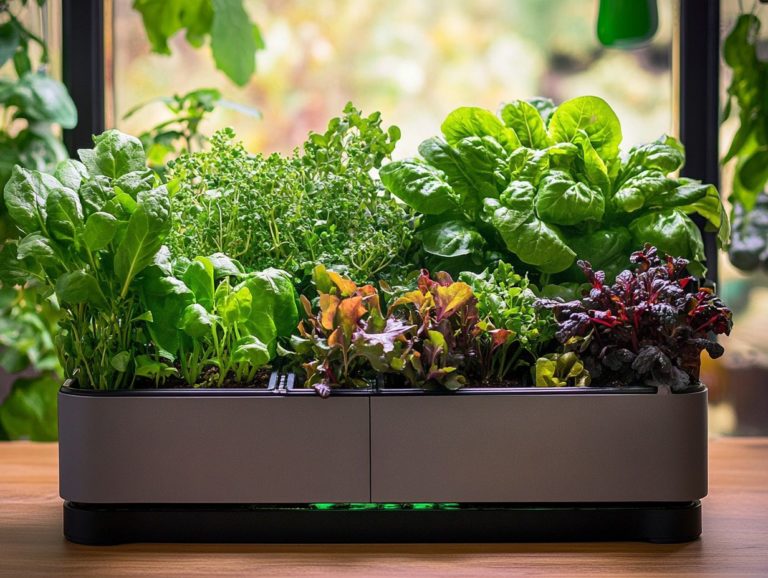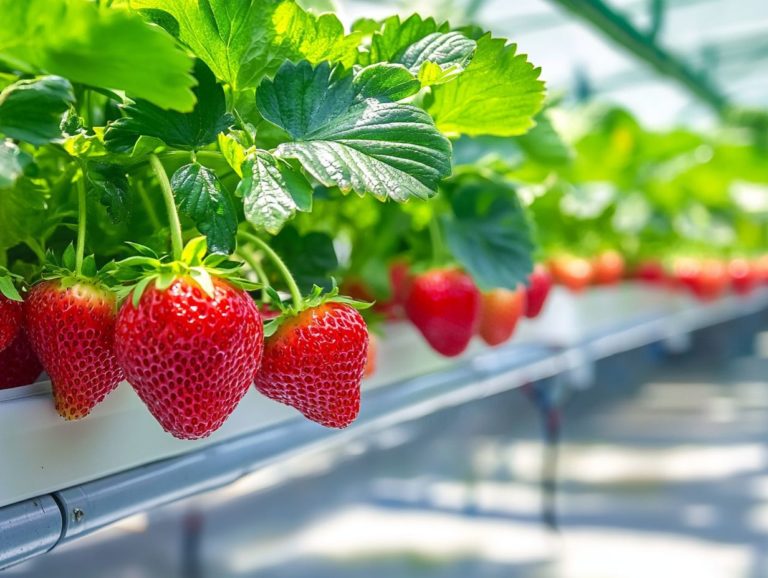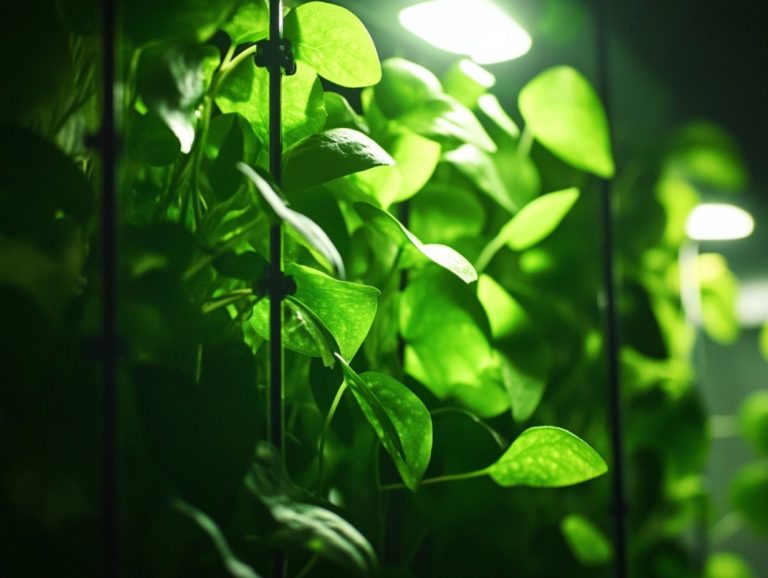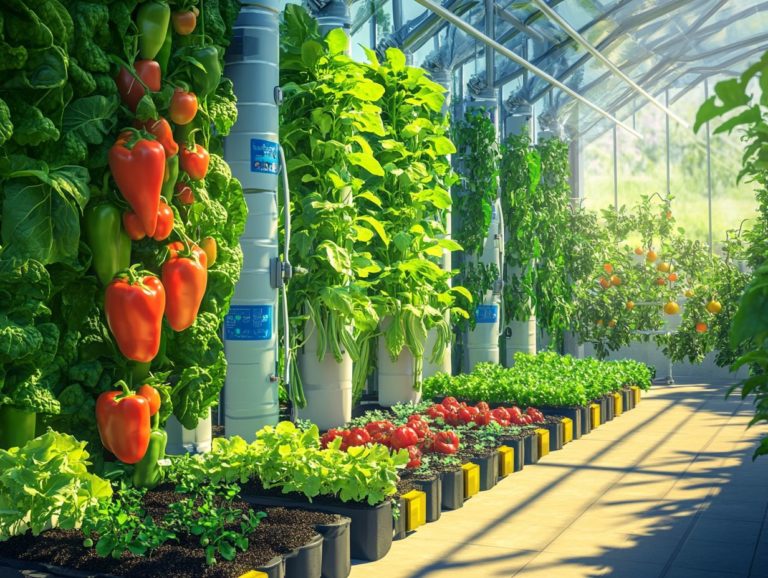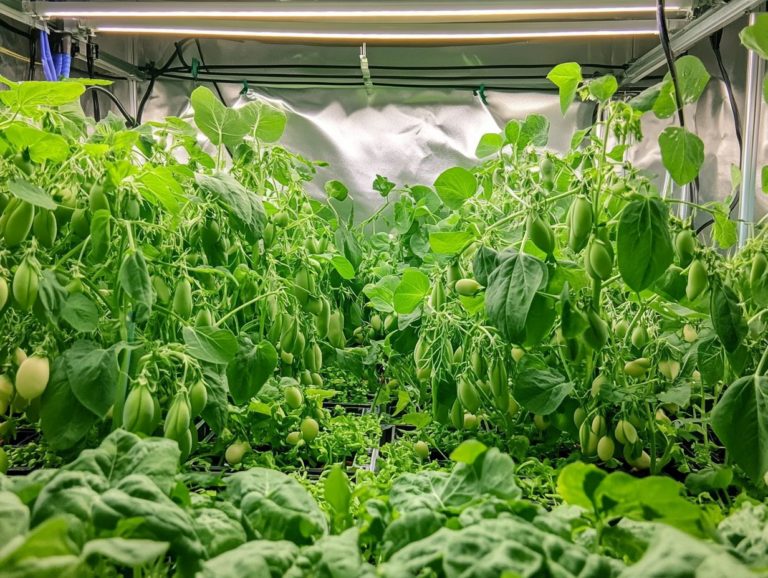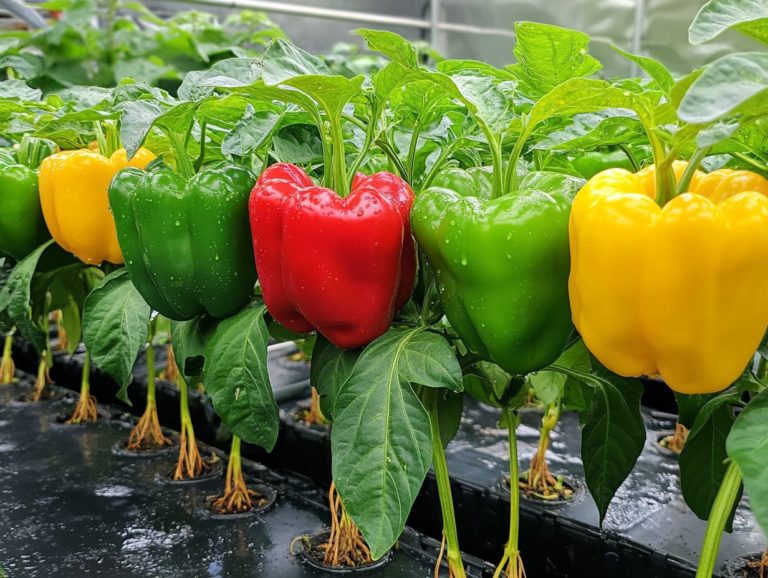“Guide to Growing Hydroponic Cucumbers”
Hydroponic gardening is revolutionizing your food-growing experience. This soil-free approach optimizes both space and resources, allowing you to grow cucumbers efficiently.
Get ready to uncover the amazing benefits of hydroponic cucumbers and learn how to start your own! Whether you consider yourself a seasoned gardener or an eager novice, you ll discover invaluable tips on selecting the ideal system, nurturing your plants, and enjoying a plentiful harvest.
Prepare yourself to explore the fascinating realm of cucumber plants and their growth potential in hydroponic systems!
Contents
- Key Takeaways:
- What is Hydroponic Gardening?
- Benefits of Growing Cucumbers Hydroponically
- Getting Started with Hydroponic Cucumbers
- Planting and Growing Hydroponic Cucumbers
- Harvesting and Maintaining Hydroponic Cucumbers
- Frequently Asked Questions
- What is hydroponic cucumber growing, and why choose it?
- What do I need to get started with hydroponic cucumber growing?
- Can I grow other types of plants using a hydroponic system?
- How do I maintain the nutrient solution in my hydroponic system?
- Are there any disadvantages to growing cucumbers hydroponically?
Key Takeaways:
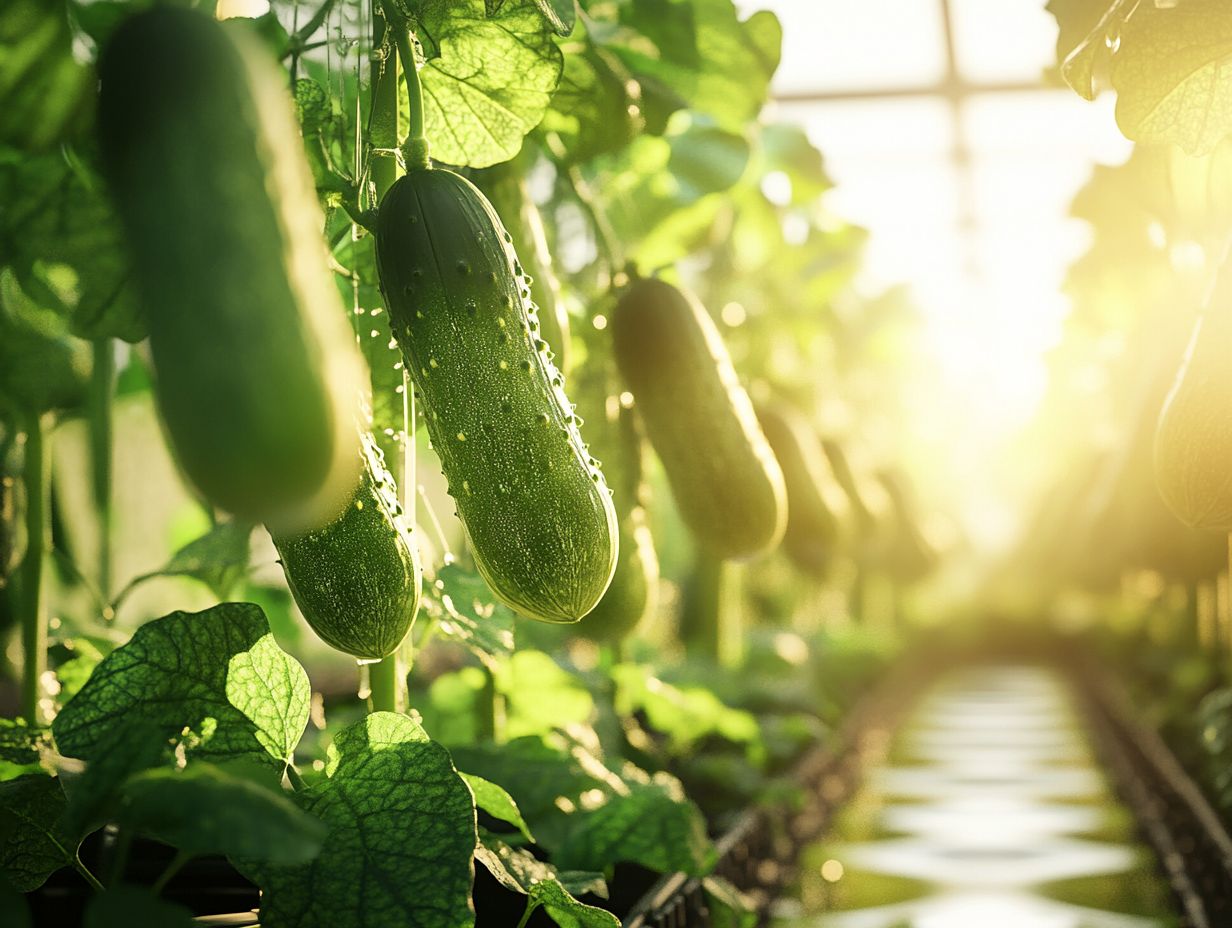
- Explore the world of hydroponic gardening and its benefits, including growing cucumbers.
- Learn how to start with hydroponic cucumbers by choosing the right system and gathering necessary supplies.
- Discover best practices for planting, caring for, harvesting, and maintaining your cucumber varieties in hydroponic systems.
What is Hydroponic Gardening?
Hydroponic gardening is a sophisticated method of cultivating plants, including hydroponic cucumbers, without the need for soil. Instead, it uses water with nutrients tailored for plants that meet the specific nutrient requirements of different cucumber varieties. This delivers essential minerals and hydration directly to the roots.
This innovative technique has garnered considerable attention from gardeners and agricultural enthusiasts. It is efficient and delivers impressive yields, especially in vegetable and greenhouse gardening, all while minimizing environmental impact.
By utilizing various hydroponic systems, such as deep water culture and ebb and flow, you can grow a diverse array of plant varieties, including cucumber patches indoors or outdoors maximizing your space and resources.
Understanding the fundamentals of this approach is essential as you explore its benefits and methods. The scientific foundation lies in optimizing plant growth, enabling germinating seeds to access nutrients more readily than in traditional soil-based methods.
With roots immersed in precisely balanced nutrient solutions, plants can swiftly absorb vital elements necessary for robust growth. This practice has historical roots, dating back to ancient civilizations that recognized the benefits of soilless cultivation, leading to innovations such as cloning cucumbers for better yields.
A variety of systems, including nutrient film technique (NFT), which involves a thin film of nutrient solution flowing over the roots, and aeroponics, where plants are misted with nutrients, cater to diverse needs and preferences. This ensures that both hobbyists and commercial growers can fully harness the potential of hydroponics.
The ability to grow vegetables indoors also allows for year-round production of cucumber plants, regardless of climate or geographic constraints. This makes hydroponics an appealing option for those interested in sustainable agriculture and indoor gardening.
Benefits of Growing Cucumbers Hydroponically
Growing cucumbers hydroponically offers many advantages that traditional soil-based gardening simply can’t match. You gain superior control over nutrient needs and light availability, leading to healthier cucumber plants and high-quality fruit.
With the hydroponic method, you can maintain optimal pH levels and tailor nutrient solutions to the specific nutrient regimen of cucumber varieties. This means faster growth rates and higher yields, especially with bush varieties like Spacemaster and Bush Champion.
Furthermore, growing indoors protects your plants from pests and diseases, and you can conveniently hand-pollinate the flowers whenever you like.
The space efficiency of hydroponic systems allows you to cultivate cucumbers in compact areas, making it perfect for urban settings or those with limited outdoor space. This method also significantly reduces water usage, as it recycles water within the system, promoting sustainable gardening practices.
With the possibility of year-round cropping, hydroponic gardening not only enhances the consistency of your cucumber harvests but also lets you explore various cucumber types. All these factors contribute to a more effective nutrient regimen, ultimately improving both flavor and nutritional content of your produce.
Start your hydroponic journey today and enjoy fresh cucumbers year-round!
Getting Started with Hydroponic Cucumbers
Starting the journey of growing hydroponic cucumbers is an exhilarating venture that marries innovation with traditional horticulture, allowing you to revel in the joys of cultivating cucumber plants with remarkable efficiency and success.
To kick off this exciting endeavor, it s crucial for you to grasp the various systems for growing plants without soil at your disposal, from deep water culture to ebb and flow setups. Each is tailored to suit different growing preferences and environmental conditions.
Select the ideal cucumber varieties, ensure proper nutrient solutions, and master seed germination for bountiful harvests of crisp cucumbers.
Choosing the Right System
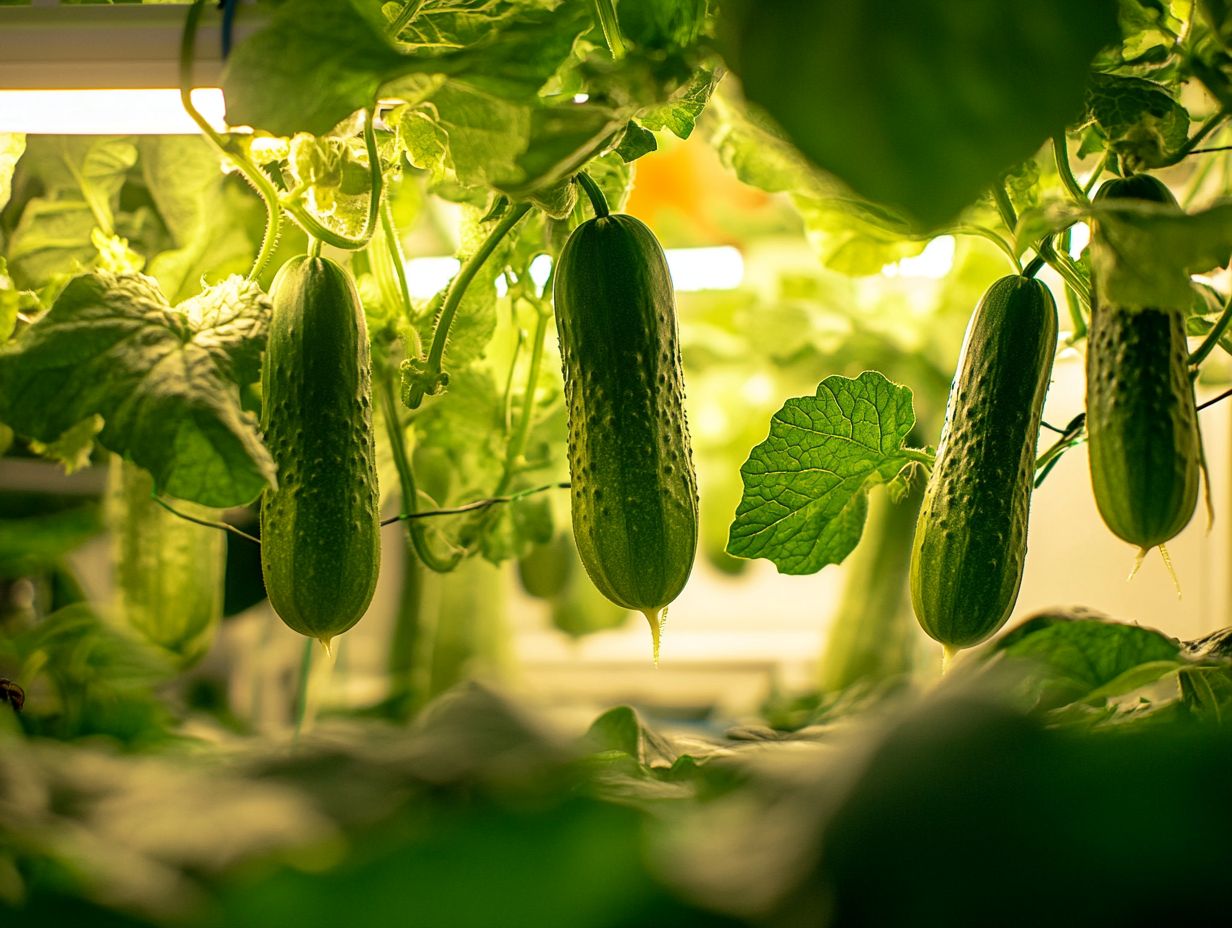
Choosing the right hydroponic system is crucial for your success in growing cucumbers. Each system presents its unique advantages and challenges, depending on your setup, maintenance capabilities, and the needs of the plants.
For example, if you re just starting out, deep water culture is a fantastic option due to its simplicity and efficiency. On the other hand, if you re looking for faster cucumber growth, the ebb and flow system excels in oxygenation and nutrient delivery.
You ll want to take stock of your available space, resources, and even the cucumber varieties you re interested in, such as bush types. These factors will significantly influence your choice and your overall success.
Don t overlook environmental considerations, particularly light requirements, which can vary widely between systems. The nutrient film technique thrives on consistent light exposure for optimal growth, while the Kratky method offers more leniency, granting you greater flexibility in light management.
Nutrient levels are another key player; some systems will demand frequent monitoring and adjustments, while others are more self-regulating. By evaluating these factors alongside the specific growth phases of cucumbers, you can make informed decisions that ensure your plants flourish in a controlled environment.
Supplies and Materials Needed
Kickstart your hydroponic adventure by gathering the right supplies now! An effective hydroponic gardening experience starts with gathering the right supplies and materials to support your growing cucumbers and create a thriving environment for your plants.
By investing in quality hydroponic systems, you establish a stable foundation for your cucumbers’ growth. Nutrient solutions, such as those offered by Dyna Gro and General Hydroponics, provide the essential elements vital for their development. Growth mediums like clay pebbles or coconut coir not only anchor roots securely but also retain moisture efficiently.
Monitoring tools for light intensity, pH levels, and nutrient concentrations are crucial. They enable you to maintain optimal conditions that promote steady growth and robust yields. With these supplies at your disposal, you can cultivate a balanced ecosystem that supports your cucumbers from seedling stage all the way to harvest.
Planting and Growing Hydroponic Cucumbers
Planting and nurturing hydroponic cucumbers demands meticulous attention to detail and adherence to best practices, ensuring the health and productivity of your plants from germination to harvest.
Begin this rewarding journey by thoroughly preparing your hydroponic system, ensuring it s spotless and tailored to meet the specific needs of your selected cucumber varieties.
Once your seeds have germinated, the next pivotal step is to transplant them into the system, all while maintaining optimal nutrient levels and light conditions. This careful approach ensures your plants thrive and rewards you with a bountiful harvest of delectable cucumbers.
Preparing the System
Preparing your hydroponic system is an essential step that sets the stage for successfully growing cucumbers. This involves not just setting up the system but also adjusting the nutrient solution and ensuring optimal pH levels and light conditions.
The way you prepare influences not only the growth rate of your cucumber plants but also minimizes the risk of diseases and nutrient deficiencies, which is crucial for vegetable plants. By understanding the specific needs of your chosen cucumber varieties and tailoring your setup accordingly, including light requirements, you will cultivate a thriving environment for your crops.
- Start by thoroughly sanitizing all system components. This is crucial as it helps prevent harmful pathogens from interfering with growth.
- Once everything is sanitized, mix the nutrient solution according to guidelines that align with the specific developmental stages of your cucumber varieties.
- Monitoring and adjusting the pH level of the nutrient solution is vital to ensure the availability of essential nutrients.
Don t overlook light requirements! Setting up grow lights that mimic natural sunlight for about 12-16 hours a day can significantly boost photosynthesis. By following these steps for seed germination and transplanting, you ll establish the groundwork for a successful hydroponic experience.
Caring for Cucumber Plants
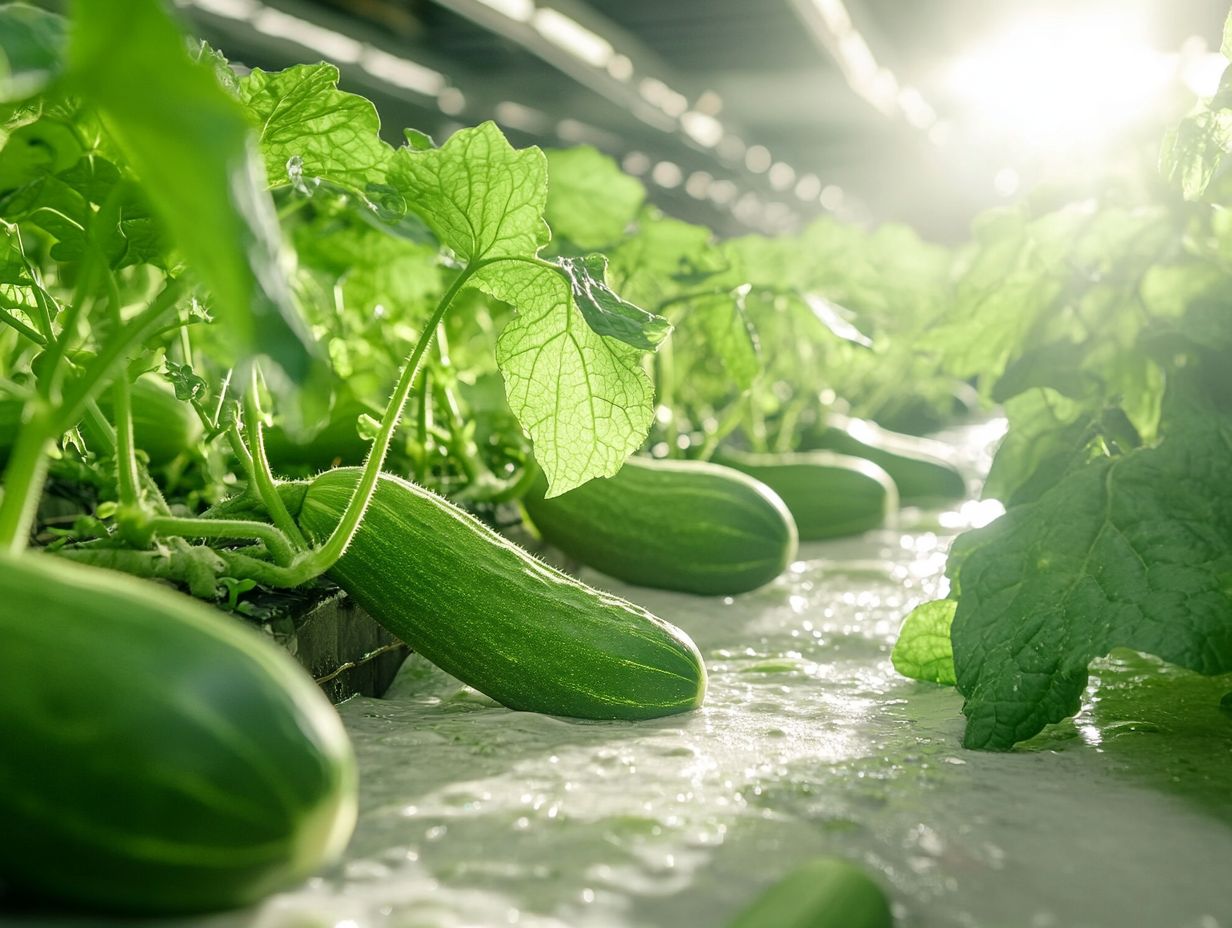
Caring for your cucumber plants in a hydroponic setup is crucial for achieving healthy growth and maximizing yield. This involves monitoring nutrient requirements, providing sufficient light, and facilitating hand pollination during the flowering stage.
By implementing these strategies, you can help your cucumber plants thrive in their nutrient-rich environment and yield high-quality fruit. Regularly check for pests and diseases while making consistent nutrient adjustments to maintain the health of your hydroponic cucumbers throughout their growing cycle.
To further optimize this process, establish a consistent watering schedule that prevents both overwatering and underwatering. Your cucumbers will thrive and flourish in bright light! Aim to provide at least 12-14 hours of light daily to enhance photosynthesis and foster robust growth, whether you are growing indoors or growing outdoors.
As the plants enter the flowering phase, mastering hand pollination techniques can significantly boost fruit set, especially in high-density setups where natural pollinators may be scarce. Being aware of seasonal changes in temperature and light helps you adjust your care routine, ensuring your cucumbers receive the ideal conditions they need to flourish and thrive like the best cucumber varieties.
Harvesting and Maintaining Hydroponic Cucumbers
Harvesting hydroponic cucumbers with precision and maintaining the system after the harvest are crucial elements of successful gardening that can significantly enhance both productivity and plant health. Different cucumber varieties may require unique harvesting techniques.
Recognizing the ideal moment to pick your cucumbers is vital. Pick them at their peak ripeness for delicious, fresh flavor!
Once the harvest is complete, careful upkeep of the hydroponic system including thorough cleaning and addressing any issues that arise will set the stage for future growing cycles and prolong the life of your cucumber plants. Consider transplanting some of your plants or cloning cucumbers to maximize your yield.
When to Harvest
Knowing when to harvest cucumbers is essential for achieving the best flavor and texture. Picking them at just the right moment can significantly elevate the quality of your yields. Aim to harvest cucumbers when they reach their ideal size and color, which varies by type, and before they turn overripe or begin to yellow.
Inspect your cucumber plants regularly to gauge their readiness for harvesting and enjoy a bountiful crop of fresh, crisp cucumbers.
Your monitoring should focus not only on size but also on the firmness of the fruit; they should feel solid, not soft. For instance, standard slicing cucumbers typically reach maturity at around 6 to 8 inches long, while pickling varieties are best harvested when they re smaller, around 4 to 6 inches.
By paying close attention, you can avoid common issues and enjoy a fantastic harvest! Leaving cucumbers too long on the vine can lead to bitter flavors or a spongy texture.
Once you ve harvested, consider the many post-harvest possibilities, like pickling or tossing them into salads, or exploring recipes that utilize fresh, crisp cucumbers to enhance your culinary enjoyment of your hard work.
Tips for Maintenance and Troubleshooting
Regular maintenance and effective troubleshooting can significantly boost your success rate in growing hydroponic cucumbers. By adopting these practices, you can proactively prevent common issues and ensure your cucumber plants thrive.
Key maintenance tasks involve monitoring nutrient levels, pH balance, and environmental conditions to cultivate an optimal growth atmosphere. Swiftly recognizing and addressing any nutrient deficiencies, pests, or diseases can help you sidestep potential setbacks and keep your hydroponic system productive.
To maintain this delicate balance, conduct routine checks on your nutrient solution at least once a week. Pay close attention to fluctuations in electrical conductivity (EC), as these changes may indicate shifts in nutrient uptake. Regular adjustments to the pH are also crucial; an imbalance can hinder nutrient absorption, especially for essential elements like nitrogen and potassium.
Keeping humidity and temperature levels in check promotes healthy growth and helps prevent mold and mildew, which are common environmental threats.
Investing in quality sensors to monitor these factors can prove invaluable. They allow you to take proactive measures before minor issues escalate into major problems, ensuring your hydroponic garden flourishes.
Frequently Asked Questions
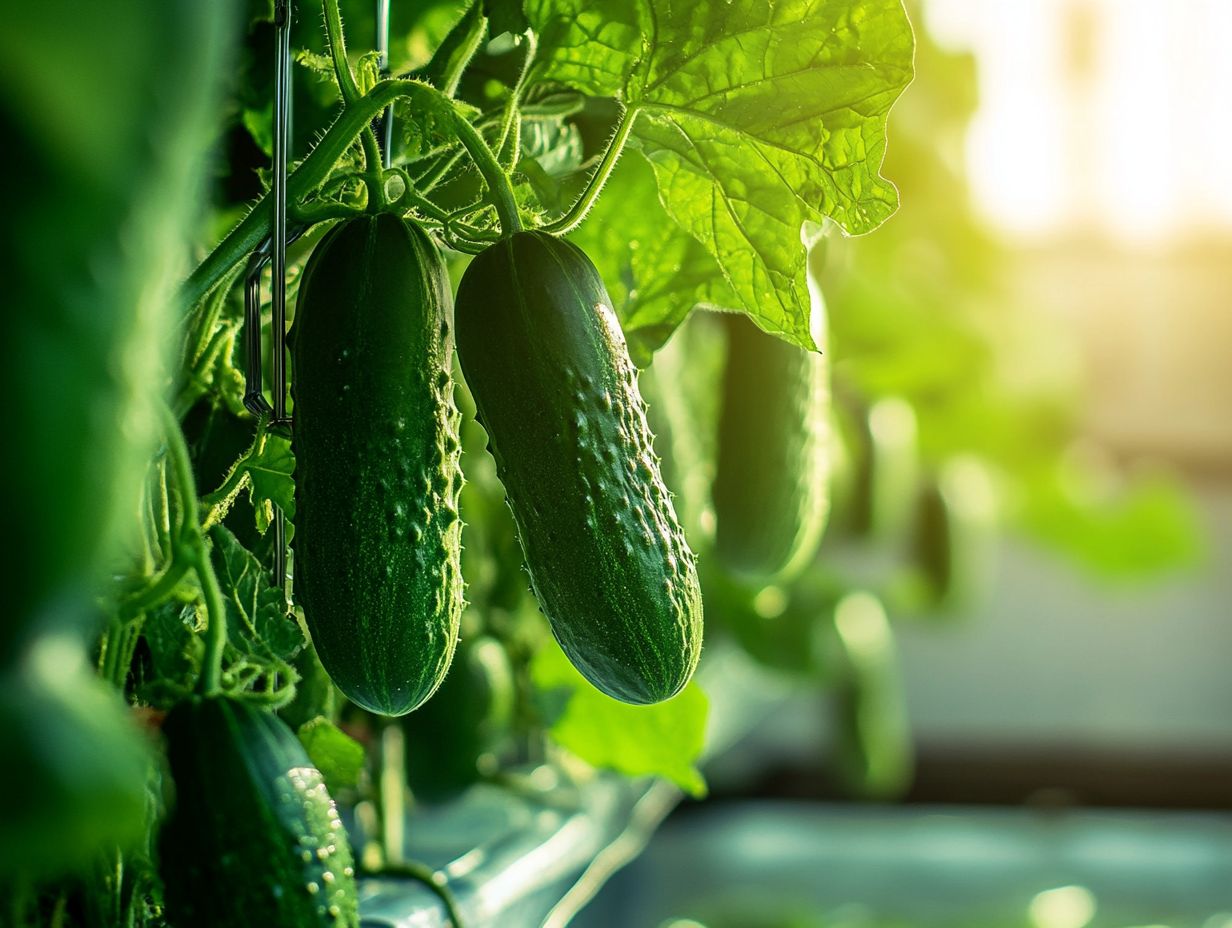
What is hydroponic cucumber growing, and why choose it?
Hydroponic cucumber growing is a method of cultivating cucumbers without soil, using a nutrient-rich solution and a controlled environment. This method offers a number of benefits, including faster growth, higher yields, and the ability to grow cucumbers in any season, whether you prefer growing indoors or growing outdoors.
What do I need to get started with hydroponic cucumber growing?
To get started, you will need a hydroponic system, nutrient solution, germinating seeds, and a suitable growing location with proper lighting and temperature control, especially for vegetable gardening.
Can I grow other types of plants using a hydroponic system?
Yes, a hydroponic system can be used to grow a variety of plants, including herbs, leafy greens, and even some fruits and vegetables.
How do I maintain the nutrient solution in my hydroponic system?
You will need to regularly check and adjust the pH and nutrient levels in your hydroponic system to ensure the plants receive the proper amount of nutrients. It is recommended to change the solution every 1-2 weeks.
Are there any disadvantages to growing cucumbers hydroponically?
Some disadvantages of hydroponic cucumber growing include the initial cost of setting up a system, the need for regular maintenance and monitoring, and the potential for system malfunctions or failures, which can make outdoor gardening seem more appealing.

